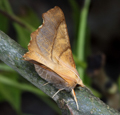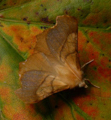Dusky Thorn
Ennomos fuscantaria
Checklist Number70.235 [B&F: 1914]
Verification
Record will normally be accepted but photo evidence may be required - check with CMR if not sure of identity
Classification
| Family: | Geometridae |
| Subfamily: | Ennominae |
| Genus: | Ennomos |
| Species: | fuscantaria |
| Authority: | (Haworth, 1809) |
Common in woodland, hedgerows and gardens throughout much of England, a species of conservation concern under the UK Biodiversity Action Plan. In Hampshire and on the Isle of Wight although described as 'common and widespread' in the 2001 county history, this species was identified by a well-publicised long-term Rothamsted survey as having undergone a 98 decline between 1970 and 2005. Looking at the population graph shown below, it would be true to say that the position of Dusky Thorn mirrored the national picture towards the end of the 1990s, but since then, the population seems to have exploded, and it is now found at higher numbers than at any time in the past four decades.
The reason for this increase remains unclear, and although it may perhaps be at least partially explained by greater recording effort since it's plight was revealed, this cannot be the whole story. Wingspan 38-42 mm. The most likely confusion species is August Thorn E. quercinaria, which also often has discal third of forewing darker, but in Dusky Thorn the two median fasciae converge at the dorsum more noticeable than they do in August Thorn, and the postmedian fascia is smoother and less kinked towards the costa in Dusky Thorn. Larva feeds on Ash, over-wintering as an egg.
The reason for this increase remains unclear, and although it may perhaps be at least partially explained by greater recording effort since it's plight was revealed, this cannot be the whole story. Wingspan 38-42 mm. The most likely confusion species is August Thorn E. quercinaria, which also often has discal third of forewing darker, but in Dusky Thorn the two median fasciae converge at the dorsum more noticeable than they do in August Thorn, and the postmedian fascia is smoother and less kinked towards the costa in Dusky Thorn. Larva feeds on Ash, over-wintering as an egg.


The abundance in each month is indicated as follows:
 No records
No records Very occasional
Very occasional Irregular
Irregular Uncommon
Uncommon Off-peak, but not unusual
Off-peak, but not unusual Off-peak, but not unusual
Off-peak, but not unusual Main flight time
Main flight time| J | F | M | A | M | J | J | A | S | O | N | D | |
|---|---|---|---|---|---|---|---|---|---|---|---|---|
| Adult |  |  |  |  |  |  |  |  |  |  |  |  |
| Larval |  |  |  |  |  |  |  |  |  |  |  |  |
()(IMG_5766).jpg)


()(IMG_5763).jpg)
()(IMG_5766).jpg)